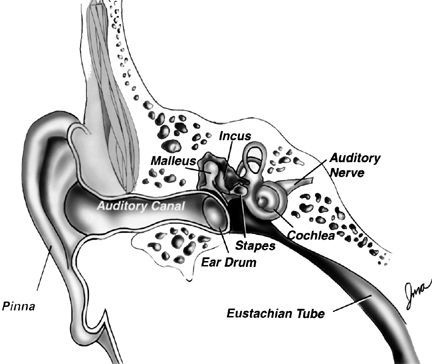
Engineers have created a silicon version of a key organ of hearing, using manufacturing techniques borrowed from the electronic chips industry. The device could serve as a prototype for mechanical sensors that function like a real ear.
The human cochlea, no bigger than the tip of your little finger, sits coiled deep within your head like miniature snail gazing out of the ear canal. From this snug vantagepoint, each translates incoming sound waves into electrical impulses that the brain understands.
The inside of the cochlea is divided into three fluid-filled chambers separated by two thin membranes, one of which is the vibrating basilar membrane. The surface of the basilar membrane is covered with tens of thousands of hairlike fibers that vibrate like miniature tuning forks when sound waves of specific frequencies pass over them.
The nearly life-sized mechanical version, built by Karl Grosh and Robert White at the University of Michigan, works in the same way as the human cochlea.
In the human version, the end of the basilar membrane closest to the eardrum is narrow and taut and covered with fibers that are short and stiff, while the other end is wider and more flexible, covered with fibers that are longer and more limber. These physical differences allow the basilar membrane to separate and transmit sounds according to their frequency.
Frequency is a measure of pitch, and is measured in cycles per second, or hertz (Hz); the higher a sound's pitch, the higher its frequency. The human cochlea can detect frequencies ranging from 20Hz to 20,000Hz.
"20Hz corresponds roughly to the deep rumble your subwoofer makes at its lowest setting, while 20,000Hz is like a very, very high-pitched whistle," Grosh explained.
Sign up for the Live Science daily newsletter now
Get the world’s most fascinating discoveries delivered straight to your inbox.
While the engineered cochlea can detect the same frequency range as a human cochlea, nature's version remains unmatched when it comes to frequency filtering, the ability to distinguish sounds that are similar in pitch. "This is due to cells known as outer hair cells and their stereocilia, whose precise function is not yet completely understood," Grosh told LiveScience. The sharp filtering may also be a result of other structures in the ear that the cochlea connects to.
To build the device, the researchers used a technique borrowed from electronic chip manufacturing called deep reactive ion etching. This, along with its nearly life-like size, sets Grosh and White's cochlea apart from past attempts by other researchers. Their model also benefits from silicon oil that mimics the more complicated interactions that occur in the human cochlea that helps in frequency filtering.
The device could one day lead to more efficient cochlear implants, Grosh said, but he cautions that such a goal is still far off. In the meantime, he believes the devices could be used for speech and music recognition and as mechanical sensors in commercial and military equipment.











